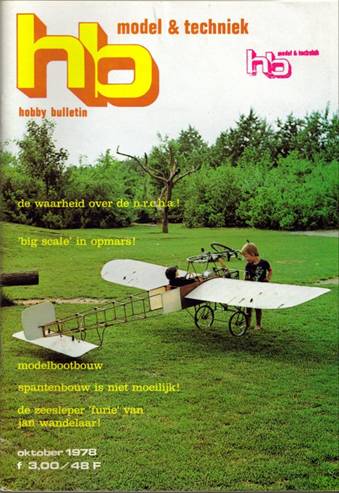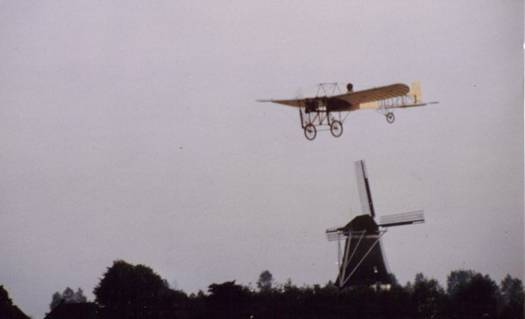The first models
Text: Henk van Hoorn
 In
the spring of 2006 the idea originated to build another Bleriot XI.
In
the spring of 2006 the idea originated to build another Bleriot XI.
Another? ... yes, for there have been some predecessors.
The first model also was my first experience with 'Big Scale' models and it
stemmed from 1978. Building to exact scale was not the target then and
everything that would exceed 5 kgs of weight and would not fit in the trunk of a
car was mere Terra Incognita for me.
Lack of knowledge was no burden and in no time
a crate was built to a scale of 1:2.5 and spanning 3.40 meters.
With a starting weight of 14 kgs. it remained to be seen if something like that
would ever leave the ground at all and if so wether it would be
controllable.
Construction was simple and consisted mainly of Ramin and thin plywood. The first
engine was an JLO 36 ccm. two-stroke donated to me by a business relation
(manufacturer of leaf-blowers)
The whole lot was loaded into a Volkswagen Van and transported to the model
flying field near the town of Wezep where the NVLC held residence.
The field proved far too small and we had to look around for another
location.
In those days anything went and getting permission to fly on the military
airfield of Deelen was just a matter of one telephonecall.
Despite the lack of power I managed to slightly damage the plane and in 5
minutes the fun was over.
The engine was replaced by one with 58 ccm, the angles of incidence were
adjusted and off we went for Deelen again.
It flew!!
The next flight was to take place in Harsewinkel, Germany. De top brass there
more than liked what was coming out of that trailer but the idea that it was
going to be controlled by a 27 MC set didn't appeal to the PR sense of the
Simprop people at all.
So all of a sudden, I was endowed with a Profi Set, for the weekend at least,
and of course the press was duly informed.
Encouraged by the succes of this first Bleriot in 1982 there appeared a
second one.
In those days a model aeroplane must weigh under 5 kgs. and if you managed to
motivate the need for more weight in a request to the Rijks Luchtvaart dienst
(the Civil Aviation Authority) you could get permission to go up to 20 kgs.
 That
opened the road to a larger model, and this time the target was set at a 1:2.2
copy of the channelflyer.
That
opened the road to a larger model, and this time the target was set at a 1:2.2
copy of the channelflyer.
The scale accuracy was to be improved as well wich meant that the sketches used
so far could no longer serve their purpose.
Internet hardly existed and so the search for better documentation started.
Not every detail was made to exact scale but the overall impression was a
very nice resemblance with the original.
Spanning 3.90 m. equipped with a 90 cc. chainsaw engine and 19 kg. takeoff
weight there was nothing in sight that could compete with it.
Even before another excursion to Harsewinkel took place RC component
manufacturer Microprop got wind of the project and sure enough a
package containing the most exclusive RC set complete with servo's dropped on
the doormat.
I flew the plane for many years and at present it is still in the private
museum of the German model flyer Jorg Vogelsang

 That
opened the road to a larger model, and this time the target was set at a 1:2.2
copy of the channelflyer.
That
opened the road to a larger model, and this time the target was set at a 1:2.2
copy of the channelflyer.  In
the spring of 2006 the idea originated to build another Bleriot XI.
In
the spring of 2006 the idea originated to build another Bleriot XI.